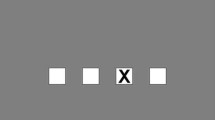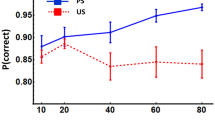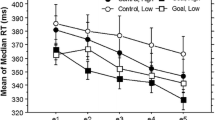Abstract
Some data suggest that, as in explicit serial learning, longer sequences are more difficult to learn implicitly. These findings have been used to support the inference that implicit learning is capacity-limited. However, investigations of the effect of sequence length on implicit learning have confounded sequence structure with sequence length. These factors were manipulated independently in 3 experiments using a serial reaction time task. The results showed that sequence structure, not sequence length, largely determines the extent of sequence learning.
Similar content being viewed by others
References
Attneave, F. (1959). Application of information theory to psychology. New York: Holt, Rinehart, and Winston.
Cleeremans, A. (1993). Attention and awareness in sequence learning. Proceedings of the 15th Annual Conference of the Cognitive Science Society (pp. 330–335). Hillsdale, NJ: Erlbaum.
Cleeremans, A., & McClelland, J. L. (1991). Learning the structure of event sequences. Journal of Experimental Psychology: General, 120, 235–253.
Cohen, A., Ivry, R. I., & Keele, S. W. (1990). Attention and structure in sequence learning. Journal of Experimental Psychology: Learning, Memory, and Cognition, 16, 17–30.
Ebbinghans, H (1964/1885). Memory: A contribution to experimental psychology. New York; Dover
Frensch, P. A., & Miner, C. S. (1994). Effects of presentation rate and individual differences in short-term memory capacity on an indirect measure of serial learning. Memory & Cognition, 22, 95–110.
Garner, W. R., Hake, H. W., & Eriksen, C. W. (1956). Operationism and the concept of perception. Psychological Review, 63, 149–159.
Howard, D. V., & Howard, J. H. (1989). Age differences in learning serial patterns: Direct versus indirect measures. Psychology and Aging, 4, 357–364.
Howard, D. V., & Howard, J. H. (1992). Adult age differences in the rate of learning serial patterns: Evidence from direct and indirect tests. Psychology and Aging, 6, 232–241.
Howard, J. H., Mutter, S. A., & Howard, D. V. (1992). Serial pattern learning by event observation. Journal of Experimental Psychology: Learning Memory, and Cognition, 18, 1029–1039.
Jacoby, L. L. (1983). Remembering the data: Analyzing interactive processes in reading. Journal of Verbal Learning and Verbal Behavior, 22, 485–508.
Jacoby, L. L., Woloshyn, V., & Kelley, C. (1989). Becoming famous without being recognized: Unconscious influence of memory produced by dividing attention. Journal of Experimental Psychology: General, 118, 115–125.
Jiménez, L., Méndez, C., & Cleeremans, A. (1996). Comparing direct and indirect measures of sequence learning. Journal of Experimental Psychology: Learning, Memory, and Cognition, 22, 948–969.
Keele, S. W., & Jennings, P. J. (1992). Attention in the representation of sequence: Experiment and theory. Human Movement Science, 11, 125–138.
Logan, G. D. (1988). Toward an instance theory of automatization. Psychological Review, 95, 492–528.
Miller, J. (1988). A warning about median reaction time. Journal of Experimental Psychology: Human Perception and Performance, 14, 539–543.
Nissen, M. J., & Bullemer, P. (1987). Attentional requirements of learning: Evidence from performance measures. Cognitive Psychology, 19, 1–32.
Pascual-Leone, A., Grafman, J., Clark, K., Stewart, B. A., Massaquoi, S., Lou, J., & Hallett, M. (1993). Procedural Learning in Parkinson's disease and cerebellar degeneration. Annals of Neurology, 34, 594–602.
Reed, J., & Johnson, P. (1994). Assessing implicit learning with indirect tests: Determining what is learned about sequence structure. Journal of Experimental Psychology: Learning, Memory and Cognition, 20, 585–594.
Restle, F. (1970). Theory of serial pattern learning: Structural trees. Psychological Review, 77, 481–495.
Shanks, D. R., & St. John, M. F. (1994). Characteristics of dissociable human learning systems. Behavioral and Brain Sciences, 17, 367–447.
Shannon, C. E. (1951). Prediction and entropy of printed English. Bell System Technical Journal, 30, 50–64.
Stadler, M. A. (1992). Statistical structure and implicit serial learning. Journal of Experimental Psychology: Learning, Memory, and Cognition, 18, 318–327.
Stadler, M. A. (1993). Implicit serial learning: Questions inspired by Hebb (1961). Memory & Cognition, 21, 819–827.
Stadler, M. A. (1995). The role of attention in implicit learning. Journal of Experimental Psychology: Learning, Memory and Cognition, 21, 674–685.
Vitz, P. C., & Todd, T. C. (1969). A coded element model of perceptual processing of sequential stimuli. Psychological Review, 76, 433–449.
Author information
Authors and Affiliations
Corresponding author
Rights and permissions
About this article
Cite this article
Stadler, M., Neely, C.B. Effects of sequence length and structure on implicit serial learning. Psychol. Res 60, 14–23 (1997). https://doi.org/10.1007/BF00419677
Received:
Accepted:
Issue Date:
DOI: https://doi.org/10.1007/BF00419677




